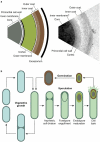Pathogenicity and virulence of Clostridioides difficile
- PMID: 36419222
- PMCID: PMC9815241
- DOI: 10.1080/21505594.2022.2150452
Pathogenicity and virulence of Clostridioides difficile
Abstract
Clostridioides difficile is the most common cause of nosocomial antibiotic-associated diarrhea, and is responsible for a spectrum of diseases characterized by high levels of recurrence, morbidity, and mortality. Treatment is complex, since antibiotics constitute both the main treatment and the major risk factor for infection. Worryingly, resistance to multiple antibiotics is becoming increasingly widespread, leading to the classification of this pathogen as an urgent threat to global health. As a consummate opportunist, C. difficile is well equipped for promoting disease, owing to its arsenal of virulence factors: transmission of this anaerobe is highly efficient due to the formation of robust endospores, and an array of adhesins promote gut colonization. C. difficile produces multiple toxins acting upon gut epithelia, resulting in manifestations typical of diarrheal disease, and severe inflammation in a subset of patients. This review focuses on such virulence factors, as well as the importance of antimicrobial resistance and genome plasticity in enabling pathogenesis and persistence of this important pathogen.
Keywords: CDI; antimicrobial resistance; c. difficile; spores; toxins; virulence factors.
Conflict of interest statement
RPF has an active collaboration with Summit Therapeutics and they are CASE partner for JEB’s PhD studentship.
Figures
References
-
- ECDC , n.d. Clostridium difficile infections - facts and surveillance [WWW Document]. European Centre for Disease Prevention and Control [cited 2022 Mar 22]. Available from https://www.ecdc.europa.eu/en/Clostridium-difficile-infections/facts
-
- Rupnik M, Wilcox MH, Gerding DN.. Clostridium difficile infection: new developments in epidemiology and pathogenesis. Nature rev Microbiol. 2009;7(7):526–536. - PubMed
Publication types
MeSH terms
Substances
Grants and funding
LinkOut - more resources
Full Text Sources
Research Materials



